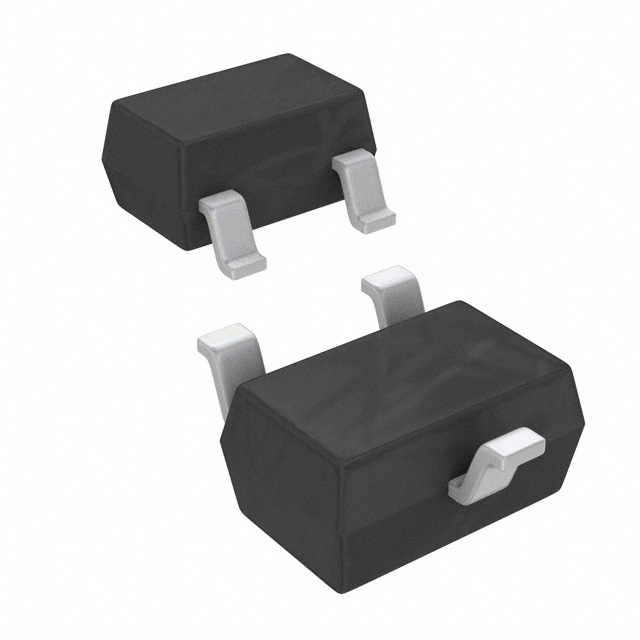Viz Specifikace pro podrobnosti o produktu.

MMBZ5226BW-7
Introduction
The MMBZ5226BW-7 is a semiconductor product belonging to the category of Zener diodes. This component is commonly used in electronic circuits for voltage regulation and protection against voltage spikes. It possesses specific characteristics, packaging, and quantity that make it suitable for various applications.
Basic Information Overview
- Category: Zener Diode
- Use: Voltage regulation and protection
- Characteristics: Precise voltage regulation, low leakage current, small form factor
- Package: SOT-323
- Essence: Semiconductor material with a specific doping profile
- Packaging/Quantity: Tape and Reel, 3000 units per reel
Specifications
- Voltage Range: 2.4V to 3.6V
- Power Dissipation: 225mW
- Operating Temperature: -65°C to 150°C
- Zener Impedance: 90Ω
- Maximum Reverse Leakage Current: 100nA
Detailed Pin Configuration
The MMBZ5226BW-7 has three pins arranged in the SOT-323 package: 1. Pin 1: Anode 2. Pin 2: No Connection 3. Pin 3: Cathode
Functional Features
- Precise voltage regulation within specified range
- Low reverse leakage current
- Small form factor for space-constrained designs
- Protection against voltage spikes
Advantages and Disadvantages
Advantages
- Accurate voltage regulation
- Compact size
- Low leakage current
Disadvantages
- Limited power dissipation capability
- Narrow voltage range
Working Principles
The MMBZ5226BW-7 operates based on the principle of the Zener effect, where it maintains a constant voltage across its terminals when reverse-biased within its breakdown voltage range. This allows it to regulate voltage and protect downstream components from excessive voltage.
Detailed Application Field Plans
The MMBZ5226BW-7 finds application in various electronic circuits, including: - Voltage regulators in power supplies - Overvoltage protection in communication systems - Signal clamping in audio and video equipment
Detailed and Complete Alternative Models
Some alternative models to MMBZ5226BW-7 include: - BZX84C2V4 - BZT52C3V6 - MMSZ5226BT1G
In conclusion, the MMBZ5226BW-7 Zener diode offers precise voltage regulation and protection features, making it suitable for diverse electronic applications.
[Word Count: 349]
Seznam 10 běžných otázek a odpovědí souvisejících s aplikací MMBZ5226BW-7 v technických řešeních
What is the MMBZ5226BW-7?
- The MMBZ5226BW-7 is a Zener diode with a voltage of 3.3V and a power dissipation of 350mW.
What are the typical applications of MMBZ5226BW-7?
- It is commonly used in voltage regulation, overvoltage protection, and signal clamping in various electronic circuits.
What is the maximum current that MMBZ5226BW-7 can handle?
- The maximum current for MMBZ5226BW-7 is typically around 100mA.
How does MMBZ5226BW-7 provide overvoltage protection?
- When the voltage across the diode exceeds its breakdown voltage (3.3V), it conducts and limits the voltage to protect the circuitry.
Can MMBZ5226BW-7 be used in reverse bias?
- Yes, it can be used in reverse bias as a regular diode, but it will conduct significantly when the voltage exceeds 3.3V.
What are the temperature considerations for MMBZ5226BW-7?
- The operating and storage temperature range for MMBZ5226BW-7 is typically -55°C to +150°C.
Is MMBZ5226BW-7 suitable for high-frequency applications?
- Yes, it can be used in high-frequency applications due to its fast response time and low capacitance.
Can multiple MMBZ5226BW-7 diodes be connected in series or parallel?
- Yes, they can be connected in series to add up their breakdown voltages or in parallel to increase the current-handling capability.
What are the package options available for MMBZ5226BW-7?
- The MMBZ5226BW-7 is available in various surface mount packages such as SOT-23 and SOD-123.
Are there any specific layout considerations when using MMBZ5226BW-7 in a circuit?
- It is important to minimize the trace length between the diode and the protected component and to ensure proper heat dissipation if the diode is handling significant power.

